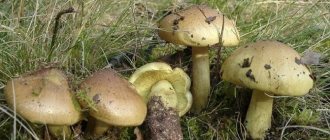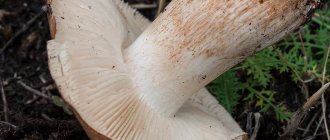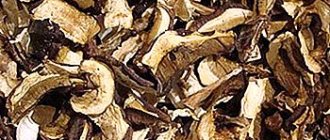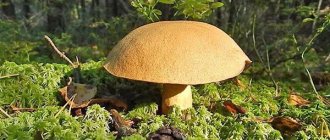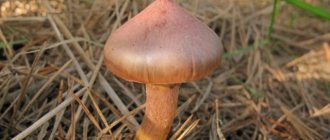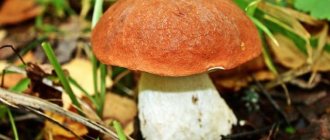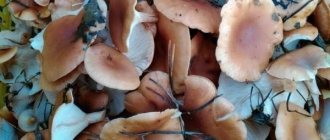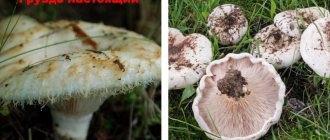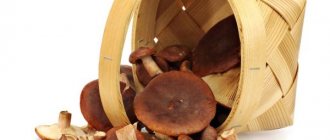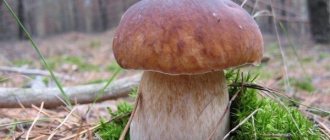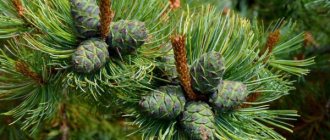Mushrooms
1
1496
Article rating
Kira Stoletova
Floaters (pusher mushrooms) are a species considered theoretically edible. It does not have high nutritional value and belongs to the Amanita genus. These are unattractive specimens both in appearance and taste.
Mushroom pushers
Brothers of the fly agaric
Pusher mushrooms - the tasty brothers of the fly agarics
Mushrooms, known as pushers or Floats, are a group of mushrooms from the fly agaric (Amanitaceae) family. There is considerable disagreement among mycologists regarding their classification - some consider them an independent genus, others a subgenus of the genus Amanita. For a simple Russian mushroom picker, however, the most important thing is that many types of Tolkachik are conditionally edible, and, with due care, are quite suitable for food.
Application in medicine
This mushroom helps prevent and eliminate health problems.
- It has a beneficial effect on the condition of the epidermis (upper layer of skin) - regenerates, eliminates peeling, itching and burning. In addition, it helps to moisturize it and quickly treat skin diseases of various etiologies.
- Increases immunity due to the high content of ascorbic acid (vitamin C). The body becomes resistant to viral and bacterial infections, as well as influenza, colds, and acute respiratory viral infections.
- Normalizes metabolic processes and water-salt balance. The fiber contained in the mushroom pulp cleanses the intestines of various toxins, removes toxins and improves metabolism, which prevents excess weight gain.
- Has a beneficial effect on the functioning of the cardiovascular system. Phosphorus and magnesium in combination provide several important functions for the body - they normalize blood pressure, cholesterol and stimulate blood flow.
- Prevents aging of the dermis (middle layer of skin). This mushroom has a powerful antioxidant effect, therefore it stops skin aging and the appearance of wrinkles, protects against the negative effects of aggressive environments and heavy metals. With regular use, the skin remains soft, elastic and velvety for a long time.
- Normalizes the functioning of the digestive tract. It has a tonic, calming and softening effect on the intestinal walls. Accelerates digestion processes. This low-calorie product does not cause a feeling of heaviness in the lower abdomen.
- Strengthens bones and joints. A large percentage of calcium is an excellent material for the structure of bone and cartilage tissue, and also prevents their destruction. Mushrooms are useful to eat for everyone who suffers from arthritis, arthrosis, osteochondrosis and polyarthritis.
- Improves vision. The main component that has a beneficial effect on the organs of vision is beta-carotene. Helps relieve fatigue during prolonged eye strain, prevents retinal detachment, the development of myopia, farsightedness and lens clouding.
- Mushrooms are useful for anemia, because they contain an increased amount of iron, vitamin C and folic acid, which together normalize the level of hemoglobin in the blood.
Floaters (pusher mushrooms) are a species considered theoretically edible. It does not have high nutritional value and belongs to the Amanita genus. These are unattractive specimens both in appearance and taste.
General characteristics of the genus
Pusher mushrooms are tasty brothers of fly agaric mushrooms.
Compared to other fly agaric genera, pusher mushrooms have relatively small fruiting bodies.
Like all fly agarics, at the first stage of development, the fruiting body of the Floats looks like a small white egg, from which the cap-footed body of the mushroom then hatches.
Their cap There may be a tubercle on the cap, its surface is usually shiny and smooth or slightly slimy. Sometimes flakes from the original cover remain on the top of the cap, and it itself is extremely fragile, which makes transporting the collected mushrooms difficult.
The color of the cap varies, depending on the species, from whitish-gray to brownish-brown or reddish-orange.
The hymenophore is plate-type, the plates are frequent, widened in the center, freely placed, white or slightly grayish-pinkish in color. Spore powder is white.
The stalk is cylindrical, fragile, and often hollow with age. Depending on the type, it can be smooth, or have a scaly pattern, bare, or covered with a flake-like coating. The leg has a downward expansion, but without the swelling characteristic of other fly agarics. The color of the legs is usually grayish-white. There is no ring on the leg.
Like all fly agarics, the volva is preserved in the lower part - the remains of the original fruiting body - the eggs. It is deeply immersed in the soil, wide and leathery, loosely covering the stem. In old fruiting bodies, sometimes it completely disappears.
The pulp is brittle and thin, white in color, unchanged when cut, sometimes faintly colored near the edges of the cap.
Mushrooms Pushers - delicious brothers of fly agarics
grow on all continents except Antarctica, in forests of various types.
What does a saffron float look like?
The appearance of the saffron float varies depending on age - young specimens are strong, stable, dense, while adults - with a fully opened cap on a thin stem - look fragile. Because of its appearance, many mushroom pickers consider it poisonous.
Description of the cap
The saffron float got its name because of the color and shape of the cap - it can have shades of orange-yellow with a brighter and more saturated center; Thanks to this color, the mushroom is clearly visible in the grass. The newly emerged saffron float has an ovoid cap; as it grows, it opens up, acquiring a hemispherical, bell-shaped shape. In adult specimens, the cap becomes flat with a small tubercle in the middle. In humid weather, its smooth, dry or slightly slimy surface acquires a characteristic shine. The cap on average reaches 40–80 mm in diameter, but in some cases it grows up to 130 mm.
With age, the frequent white plates become creamy or yellowish and appear along the edges of the cap, causing it to become ribbed. A small amount of Volva may remain on the surface.
Description of the leg
The saffron pusher has a smooth or scaly cylindrical leg, 60 to 120 mm long, 10–20 mm thick. At the base it is somewhat thicker than at the cap, and can be either straight or slightly curved. Color varies from pure white to saffron. The leg is hollow, brittle, without a ring, but the scales can form peculiar belts.
A peculiarity of this species of mushroom is the presence of a sac-like volva from which a stalk grows. In some cases it may be in the ground, but more often it is observed above its surface.
Application and beneficial properties
Pushers are conditionally edible mushrooms that require mandatory preliminary boiling before use.
The taste qualities of these mushrooms are usually not considered outstanding - their taste is defined as neutral, and the fragility of their fruiting bodies, which makes harvesting and cooking difficult, also does not add to their popularity. Before use, Tolkachiki must be properly cleaned, rinsed thoroughly with running water and boiled for an hour. After boiling, these mushrooms are suitable for various culinary purposes - they are used for appetizers, first and second courses, and can also be successfully dried and pickled.
Pusher meats are quite nutritious; they contain a lot of betaines, which have a positive effect on metabolic processes in the human body, and are also used in clinical medicine to combat diseases of the gallbladder, kidneys, liver, prostate adenoma, breast cancer and Alzheimer's disease.
The use of pushers in cooking
There are mushroom pickers who happily take pushers in the forest, but there are few such people. More often you can hear that these forest products are not valued because of their taste. Fragility also does not add positive reviews to the white float. However, pushers are used in the preparation of some dishes after a short heat treatment. This plant is suitable for drying, it is salted and pickled.
It is not difficult to prepare a delicious soup at home. The pushers are first washed in water, forest debris is removed and carefully cleaned of dirt. Then the product is placed in a large saucepan, filled with water and boiled for 40 minutes. The finished semi-finished product is washed again and crumbled into pieces. Place potatoes prepared into strips, finely chopped carrots and pieces of boiled mushrooms into the pan. The required amount of liquid is added to the food container and your favorite spices are added. The soup is boiled until the potatoes are completely cooked; the dish is served with sour cream and herbs.
Some housewives bake boiled pushers with potatoes and mushrooms. Mushroom culinary dishes have always been considered a special delicacy, but one should not forget that one should not take a dubious product in the forest in order to avoid fatal poisoning.
Not for everyone
Pusher mushrooms - tasty brothers of fly agarics
Pusher mushrooms are a type of fly agaric, and they look very similar, so not every lover of quiet hunting will dare to put them in their basket, even knowing that they are edible. However, you can eat Tolkachiki, and they also have their admirers, who make up a certain category of mushroom pickers who are quite pleased with their culinary qualities. A lot about the taste of these mushrooms depends on the place where the fruiting bodies grow and the specific species, and, partly, on the cooking technology. Although officially these mushrooms are “so-so”, some types of Tolkachik are quite popular and are considered, among their connoisseurs, to be a very tasty and healthy treat.
Mushrooms Pushers - delicious brothers of fly agarics
Places of growth of saffron pushers.
Saffron pushers bear fruit from July to the end of September; no pronounced peak of fruiting is observed. Their habitats are mixed and deciduous forests. They prefer open forests, edges and bright places. Saffron floats are often found near swamps.
Evaluating the edibility of saffron floaters.
Saffron floats are considered edible, but they are low-value mushrooms. They have very low culinary value, as they crumble easily and are practically tasteless. But it is worth noting that the other floats are even worse. Before cooking, they need preliminary heat treatment.
Similar species.
When collecting saffron floats, care should be taken as they can be confused with poisonous mushrooms - toadstools. A float can be recognized due to the fact that, unlike a toadstool, it does not have a ring on its leg.
It is difficult to find differences between floats, since the color of their caps is very variable, and they also grow in similar places. The saffron float has the greatest similarity with the gray float and with.
More meaty and larger. The shape of its cap is ovoid, bell-shaped or prostrate. The color of the cap is light gray or dark gray. Sometimes there are flaky large remnants of the bedspread on it. The pulp is soft, brittle, white, odorless with a pleasant taste. The stem is cylindrical, hollow inside, lighter than the cap, and has a flaky coating on it. Volva is free, big.
Gray floats grow everywhere. They can be found in mixed, deciduous forests and coniferous forests. They bear fruit from July to September.
The Caesar mushroom is an edible relative of the saffron float. Its cap can be ovoid or convex-spread. Its color is fiery red or orange, and when the mushroom fades, the cap turns yellow. There are large white remains of the blanket on the surface. The leg is fleshy, club-shaped, light yellow in color. There is a volva that looks like an egg shell. The pulp is dense, with a pleasant taste, hazelnut smell, and white color.
Caesar mushrooms bear fruit from June to October. You can find them in forest clearings, on the border of meadows and forests. They live under chestnut and oak trees, and in more rare cases - under birch, beech and walnut trees.
Types of Pusher Mushrooms
Float Saffron Amanita Crocea
Mushrooms Pushers - delicious brothers of fly agarics
One of the most popular and delicious Pushers.
Appearance
The cap, up to 10 cm in diameter, is initially ovoid, becoming increasingly prostrate with age. Its surface is smooth, shiny in wet weather, with a characteristic ribbed edge. The color of the cap varies from saffron-yellow to yellow-orange, always darker in the center.
The hymenophore is lamellar, the plates are frequent and free, white in young fruiting bodies, creamy-yellowish in old ones. Spore powder is white.
The leg is up to 15 cm high and up to one and a half centimeters thick, yellowish-white in color, hollow, and thickened at the base. The leg is covered with small scaly belts and does not have a ring, but may have a slight bend in the middle. The volva, at the base of the stem, can often be completely buried in the ground.
The pulp is thin and brittle, without pronounced taste or smell, light or yellowish in color.
Where and when does it grow
Saffron float grows from the beginning of July to the end of September in mixed and deciduous forests, on the edges, woodlands and other bright places. Often found in swamps.
Culinary Use
Among lovers of this type of Tolkachik, there is disagreement about the need to boil it before eating. Some people simply pour boiling water over it before using it, while others immediately fry it raw. Many connoisseurs note its sweetish, corn-like taste, and claim that this mushroom is especially good when fried.
The question of the dangers of using Floats is also very controversial. There is evidence of serious poisoning by these mushrooms. On the other hand, the very high and well-known probability of confusing the Pusher with the Pale Toadstool raises doubts that the cause of those poisonings was the floats.
Float Gray Amanita Vaginata
Pusher mushrooms are the tasty brothers of the fly agarics.
A slightly less popular species among Pusher lovers, although the taste is not inferior to the Saffron Float.
Appearance
The cap is up to 12 cm in diameter, in youth it is round - bell-shaped or conical, then it becomes, at first, convex, then almost flat, with a tubercle in the middle. The cap is fleshy in the center, furrowed and thin at the edges, its skin is shiny and smooth, slimy in wet weather. The color of the cap is highly variable - from whitish-gray to yellow-brown shades. In young specimens, remnants of the original film are sometimes visible on it.
The hymenophore is lamellar, the plates are frequent and free, with a widening in the center, light in young specimens, and yellowish in mature specimens. Spore powder is white.
The leg is up to 18 cm high and up to 2 cm in diameter, slender and thin, with a smooth narrowing upward. The surface of the leg is longitudinally fibrous and smooth, can be covered with a flocculent coating, its color varies from whitish-gray to ocher and gray-brown. At the base, the stalk is surrounded by a wide and free volva, light at first, and turning brown with age. The leg ring is missing.
The pulp is soft, fragile and thin, light or slightly yellowish, without much odor, and with a sweetish taste.
Where and when does it grow
Gray float grows from May to November in light coniferous and deciduous forests, and is found in the steppe zone and in the mountains, especially in the company of mountain pine and green soul. Ubiquitous in Eurasia and North America, found in Australia and New Zealand, and certain areas of South America.
Culinary Use
It is believed that the mushroom can lead to intoxication if consumed without prior boiling, but the nature and degree of danger of the toxins it contains has not been determined. Its nutritional qualities are approximately similar to Saffron Float.
Float Yellow – Brown Amanita Fulva
Pusher mushrooms - tasty brothers of fly agaric mushrooms
Another fly agaric-like, but quite edible species. Also called Brown Float, Orange Fly Agaric and Yellow-Brown Fly Agaric.
Appearance
The cap is up to 8–10 cm in diameter, has a convex or bell-shaped shape in young specimens, and a pronounced flat shape, with a tubercle, in mature ones. The cap is slightly mucous, with a distinctly furrowed edge. As a rule, there are no remains of the bedspread on it.
The hymenophore is lamellar, the plates are free and frequent, white or cream in color. Spore powder is light.
The leg is up to 14 cm high and up to 1.2 cm in diameter, thickening downwards. Painted white-brown, smooth, sometimes covered with small felt scales. It becomes hollow with age. The volva at the base of the leg, free and sac-like, not attached to the leg, has a reduced brown tint. There is no ring on the leg.
The pulp is thin along the edges, fleshy in the center of the cap, watery and soft, of a light color. It tastes sweetish and has no distinct odor.
Where and when does it grow
This mushroom loves acidic soils and damp wetlands, grows in coniferous and mixed forests, and is also found in the steppe zone. Fruits in small groups or singly, from June to October, widespread in the temperate zone of Eurasia and North America, found in Japan, China and North Africa, Central Asia and Transcaucasia. In Russia, the Yellow-Brown Float is quite widespread in the central and southern regions.
Culinary use
The mushroom has a very good taste and is popular among connoisseurs. No toxins were found in this form, but it is still recommended to boil it for half an hour before use. Again, many experts recommend cooking these mushrooms for no more than 5 minutes to avoid loss of taste, and some fry them directly raw.
Use in cooking
This product is in great demand among chefs - it can be canned, fried, boiled, stewed and pickled. You can take note of several interesting recipes.
Recipe 1. Soup
- young fruiting bodies - 350 g;
- potatoes - 3 pcs.;
- smoked ribs - 200 g;
- onion - 1 pc.;
- carrot - 1 pc.;
- canned green peas - 100 g;
- tofu cheese - 50 g;
- dill;
- salt pepper.
Soak the mushrooms in cold water for an hour. Peel the onion and chop it. Grate the carrots on a fine grater. First fry the onion in vegetable oil until golden brown, then add the carrots.
Boil the ribs. Peel and cut the potatoes into cubes.
Mix all the ingredients together with the frying in one saucepan, pour in a couple of liters of water, salt and pepper to taste. Place over medium heat and cook until the potatoes are fully cooked.
Add peas, grated cheese, and chopped dill. Cook for another 5 minutes, remove from heat, leave for 20 minutes. Serve with sour cream.
Recipe 2. Floats in cream
Mushrooms are versatile in cooking
A couple of hours before preparing the dish, the mushrooms are soaked in warm water. Then they are thrown into a colander, cut into pieces, and fried in vegetable oil until golden brown.
Sprinkle with grated cheese (70-80 g), salt and pepper to taste, pour over lemon juice (½ tsp) and white wine (1 tbsp). cover with a lid and simmer over low heat for 25 minutes.
Recipe 3. Marinated mushrooms
For winter preparation you will need:
- floats - 1 kg;
- salad onions - 3 pcs.;
- bell pepper, carrots - 2 pcs.;
- a small piece of horseradish root.
Soak the mushrooms in warm water for 1.5 hours, then drain in a colander, transfer to a saucepan with clean water, cook for 20 minutes, drain the water.
Peeled onions are cut into rings, carrots and sweet peppers into strips. Peel the horseradish root and cut it into thin strips. Place all chopped ingredients in sterile jars. Boiled mushrooms are placed on top up to the neck.
The last stage is pouring the marinade. To prepare it you will need for 0.5 liters of water:
- salt - 2 tsp;
- sugar - a couple of pinches;
- black currant leaves - 5 pcs.;
- bay leaf - 2-3 leaves;
- black pepper - 5 peas.
Pour water into the pan according to the proportions, add all the ingredients, bring to a boil, and boil for 1-2 minutes.
Boiling marinade is poured over the mushrooms up to the neck, rolled up, and after cooling they are taken out for storage in a cellar or basement. You can try the preparation after 3 weeks.
Irina Selyutina (Biologist):
When preparing pushers (floats), you need to consider that:
- Collected mushrooms cannot be stored for a long time: they need immediate processing.
- Before cooking, all contaminants must be carefully removed from the fruiting bodies and washed thoroughly.
- It is recommended to boil the mushrooms for 40-50 minutes.
- You can salt and marinate without prior scalding or soaking.
If you want to be sure of the quality of mushrooms used for food, then remember that it is best to collect pushers, like other forest gifts, in areas with a favorable environmental situation.
The most important
Pusher mushrooms are the tasty brothers of the fly agarics.
The most important thing to know when searching for and collecting Pusher mushrooms is that they are VERY similar to the Pale Toadstool. It is this fact that makes many mushroom pickers avoid these mushrooms - and perhaps this is the safest and most sensible strategy. Those who are not afraid to risk their health must remember the main signs that distinguish Pushers from their dangerous double:
- At the very beginning, the fruiting body of the toadstool resembles a white egg, from which the stem with the embryo of the cap then hatches. That is, exactly the same as with Tolkachikov. Conclusion, under no circumstances should you collect floats in the egg stage.
- The Pale Toadstool has the famous ring on its leg, which looks like a velvety skirt. Pushers don't have a ring. However, the ring of a toadstool can fall off over time, or due to accidental mechanical impact. In this form, it is easy to confuse the toadstool and floats. Therefore, when collecting Pusher, you need to very carefully check for the presence of a ring mark on the fruiting body.
- The cap of the Pale Toadstool is smooth, without any grooves, and all floats have the edges of the cap with a signature grooved pattern.
In a similar way, Pushers are distinguished from poisonous species of fly agarics, for example from the Bright Yellow Amanita Gemmata ,
Mushrooms Pushers - delicious brothers of fly agarics
but here you need to be even more careful - fly agarics also have grooves on their caps, which makes them very difficult to distinguish from floats.
Attention to all these signs can save the health and life of a collector who decides to feast on Pusher. According to experienced experts, distinguishing them from their poisonous counterparts is not at all difficult if you follow the rules and gain a little experience.
Mushrooms Floats or Pushers are an excellent example of not the most popular, but quite edible mushrooms that can bring considerable gastronomic pleasure to true connoisseurs of mushroom delicacies. Let their close relationship with poisonous species not frighten the attentive leader of a quiet hunt, forcing him only to be especially vigilant when searching for and collecting them.
Primary processing and preparation
There are connoisseurs and amateurs who praise the taste and consistency of saffron floats prepared without pre-processing (boiling). However, given that collecting these mushrooms is risky in itself, their fruiting bodies should be boiled - preferably in two waters, each time completely draining the broth. Then the fruiting bodies processed in this way are fried, soups are cooked, and stewed. They must be prepared immediately after collection - these mushrooms cannot be stored even for short periods.
Saffron floats, also known as pushers, are strict examiners for fans and connoisseurs of mushroom dishes. Their dangerous resemblance to the bright yellow fly agaric can lead to fatal consequences. Therefore, some experts do not recommend collecting these mushrooms at all, despite their conditional edibility and good taste.
The float is white and belongs to the fly agaric family. Mushroom pickers don't like him because of his appearance. It resembles a stinking fly agaric, or a pale toadstool.
You can distinguish it, but you need to be extremely careful. The first sign of a white float is that it really is white. The cap may be slightly darker than the spore-bearing plates. It reaches fifteen centimeters in diameter, and in its center the remains of the blanket that protects the fungus during growth are clearly visible.
The edge is uneven and ribbed. This mushroom has no particular odor. When cut, the pulp does not change color.
You can find this mushroom in deciduous forests. The difference between this mushroom is the ribbed edges of the cap, a pouch at the base and the absence of a ring on a thin, high stem. These mushrooms can only be collected from July to the end of September.
These mushrooms can be used in cold appetizers, as well as stewed and fried, but they must first be boiled.
The float is white. White pusher (Amanitopsis alba) photo
It is found in autumn in birch and coniferous forests with an admixture of birch, very rarely and not abundantly. The entire mushroom is snow-white. Otherwise the same as the gray float. Edible, fourth category, pleasant to the taste.
Used boiled. The white pusher can be confused with the deadly poisonous stinking fly agaric (see comparative table).
Gray floater (Amanita vaginata)
Current title
| Index Fungorum | Amanita vaginata (Bull.) Lam. |
| MycoBank | Amanita vaginata (Bulliard) Lamarck |
Systematic position
Etymology of the specific epithet
Vaginātus, a, um mik. vaginal. From vagina, ae f 1) sheath; 2) shell, cover; husk, skin; 3) anat. vagina + -ātus, a, um quality.
Synonyms
- Agaricus vaginatus Bull., Herb. Fr. 3: tab. 98 (1783)
- Amanitopsis vaginata (Bull.) Roze, Bull. Soc. bot. Fr. 23:111 (1876)
- Agaricus plumbeus Schaeff., Fung. bavar. palat. nasc. (Ratisbonae) 4:37 (1774)
- Amanitopsis plumbea (Schaeff.) J. Schröt., in Cohn, Krypt.-Fl. Schlesien (Breslau) 3.1(41): 676 (1889)
- Agaricus hyalinus Schaeff., Fung. bavar. palat. nasc. (Ratisbonae) 4:63 (1774)
- Agaricus albus Bull., Herb. Fr. 13: tab. 597 (1793)
Other names: Amanita vaginalis.
Habit
Fruiting body: Cap and stalk (agaricoid)
Hymenophore: Lamellar (including folded or with vestigial plates)
hat
Cap (3) 5 – 10 (12) cm, initially ovoid, ovoid-bell-shaped, then opens to prostrate, with a tubercle, gray, lead-gray, rarely brownish, the tubercle is darker. Sometimes shreds of the general cover remain on the cap. About a third of the cap from the edge is striped, ribbed due to translucent plates.
The plates are white and free.
Leg
Leg 8 – 12 (19) × 0.5 – 1.5 cm, cylindrical, without a ring, slightly widening towards the base, solid at a young age, then hollow, white, sometimes with a pale gray zigzag pattern; the surface of the leg is smooth or torn by uneven flakes.
Volva is saccular, 2- or 3-lobed, sometimes narrowed at the base, its structure resembles a damp paper napkin; white, sometimes slightly grayish inside, sometimes with small rust-colored spots on the outer surface.
Microscopy
Spores 9.6 – 11.8 × 8.9 – 11.5 µm, spherical, smooth.
Basidia 47 – 55 × 15 – 19 µm, club-shaped, 4-spored.
Ecology and distribution
Substrate: Soil, litter
In deciduous, coniferous and mixed forests. Found everywhere.
Fruiting
The divisions correspond to the ten days of the month.
Nutritional properties
It should be collected very carefully. Easily confused with poisonous species
Similar species
This mushroom can be distinguished from poisonous representatives of the genus Amanita by the ribbed, striped edges of the cap and the absence of a ring on the stem.
Several more species of floats grow on the territory of Western Siberia, which differ primarily in the color of the cap and preferences for the type of habitat.
- White float (Amanita vaginata var. alba)
- Yellow-brown floater (Amanita fulva)
- Mayor's Float (Amanita mairei)
- Saffron float (Amanitopsis crocea)
- Membranous float (Amanita submembranacea)
- White floater (Amanita nivalis)
- Dark yellow float (Amanita umbrinolutea)
- Pale grebe (Amanita phalloides)
- Icelandic fly agaric (Amanita islandica)
- Amanita virosa (Amanita virosa)
Composition and calorie content of white float
The calorie content of white float per 100 g is only 24 kcal, of which:
- Proteins - 3.1 g;
- Fats - 0.8 g;
- Carbohydrates - 2.2 g;
- Dietary fiber - 2.1 g;
- Ash - 0.7 g;
- Water - 87.1 g.
Vitamins per 100 g:
- C, ascorbic acid - 10 mg;
- PP, nicotinic acid - 0.289 mg;
- B1, thiamine - 0.09 mg;
- B2, riboflavin - 0.4 mg;
- Beta-carotene - 15 mg;
- E, alpha-tocopherol - 0.9 mg.
Minerals per 100 g:
- Iron, Fe - 2.9 mg;
- Phosphorus, P - 38 mg;
- Potassium, K - 250 mg;
- Sodium, Na - 8 mg;
- Magnesium, Mg - 9 mg;
- Calcium, Ca - 10 mg;
- Manganese, Mn - 0.33 mg;
- Zinc, Zn - 0.55 mg.
Replaceable and essential acids per 100 g:
- Leucine - 0.15 g;
- Threonine - 0.13 g;
- Valine - 0.078 g;
- Phenylalanine - 0.22 g;
- Cysteine - 0.31 g.
Important! Due to the fact that white float contains protein, it can be an excellent substitute for meat and fish.
